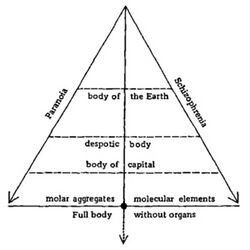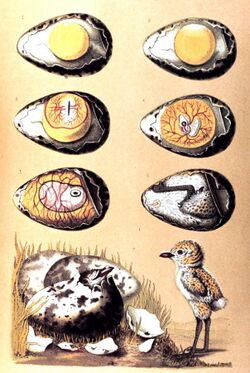Philosophy:Body without organs

The body without organs (or BwO; French: corps sans organes or CsO)[1] is a fuzzy concept used in the work of French philosophers Gilles Deleuze and Félix Guattari. The concept describes the unregulated potential of a body—not necessarily human[2]— without organizational structures imposed on its constituent parts, operating freely. The term was first used by French writer Antonin Artaud in his 1947 play To Have Done With the Judgment of God, later adapted by Deleuze in his book The Logic of Sense, and ambiguously expanded upon by himself and Guattari in both volumes of their work Capitalism and Schizophrenia.
Stemming from the general abstract notion of the body in metaphysics,[3] and the unconscious in psychoanalysis, Deleuze and Guattari theorized that since the conscious and unconscious fantasies in psychosis and schizophrenia express potential forms and functions of the body that demand it to be liberated, the reality of the homeostatic process of the body is that it is limited by its organization and more so by its organs. There are three types of the body without organs; the empty, the full, and the cancerous, according to what the body has achieved.[4]
Background
The phrase "body without organs" was first used by the French writer Antonin Artaud in his 1947 text for a play, To Have Done With the Judgment of God. Referring to his ideal for man as a philosophical subject, he wrote in its epilogue that "When you will have made him a body without organs, then you will have delivered him from all his automatic reactions and restored him to his true freedom."({{{1}}}, {{{2}}}) Artaud is regarded as having viewed the body as an impermanent, composite image of actions inflicted upon a vulnerable and repressive physical structure; in a 1933 letter, he wrote that bodies should be understood only as "provisional stratifications of states of life".[5]
Deleuze reinterpreted the term in The Logic of Sense, inspired both by Artaud's text and the work of psychotherapist Gisela Pankow;({{{1}}}, {{{2}}}) here, he conceptualized the body without organs in the context of psychoanalysis, observing that the practice as it existed refused the thorough creation of BwOs.[6] In Deleuze's early formulations of the concept, the body without organs was based in the symptoms related to schizophrenia, such as glossolalia where syllables are formlessly uttered and intoned in sets as if they were words.[7] For Deleuze, glossolalia transforms words from having instrumental value, where words have literal meaning, to "values which are exclusively tonic [relating to speech] and not written", creating—in the case of language—lingual and verbal bodies without organs.[8]
Usage
The concept of the body without organs was mainly defined by Deleuze and Guattari in the two volumes of their work Capitalism and Schizophrenia, Anti-Oedipus and A Thousand Plateaus.[9] In both books, the abstract body is defined as a self-regulating process—created by the relation between an abstract machine and a machinic assemblage—that maintains itself through processes of homeostasis and simultaneously limits the possible activities of its constituent parts, or organs.[10] The body without organs is the sum total intensive and affective activity of the full potential for the body and its constituent parts.[11]
Deleuze and Guattari presume, in a continuation from Samuel Butler's radical departure from vitalism in "Darwin among the Machines", that since all organisms have some sort of abstract inclination or desire—in the case of nonhuman life such as plants and animals, their genetic instincts variably control what actions they take—the body without organs is the inevitable, unconstrained manifestation of those inclinations or desires that may take upon unprecedented forms.[12] The concept of the body that the body without organs refers to inherits elements from both the concept of substance proposed by Baruch Spinoza and the concept of "intensive magnitude" in Immanuel Kant's Critique of Pure Reason, wherein it is defined not by closed and determinate activity but by cohesion through affective potential.[13] A body without organs can consist of many different actions that approach an unattainable goal, many of which are the activities of assemblages that people unconsciously create and are always engaged in;[14] to become a body without organs, one must dispose of stratification (the classification of constituent parts into groups), and instead give way to what Deleuze and Guattari described as an immanent "becoming" of pure intensity.[15] The body without organs is not necessarily coupled with the eradication of stratification, but rather encourages the creation of a "smooth space", immanently transforming the body beyond its existing categorization.[16]
The bodies—not merely physical but intensive—of schizophrenics, drug addicts, and hypochondriacs are examples they give of bodies without organs, but they caution against replicating their actions; people should not seek out their negative experiences, which are "catatonicized" and "vitrified".[14] While these examples are said to have abandoned stratification, they never intensified, which makes their bodies without organs vulnerable to re-stratification.[15] They classify bodies without organs into three categories:[upper-alpha 1] The empty BwO is chaotic and undifferentiated because it undergoes destratification without intensification; the full BwO is a "plane of consistency" because it is both destratified and intensified, which allows it to enter new relationships; meanwhile, the cancerous BwO is too stratified and becomes "majoritarian", having predetermined objectives that eliminate the body's potential.({{{1}}}, {{{2}}})
Two important examples of the body without organs relate to eggs.[18] As a bird egg develops, it is nothing but the dispersion of protein gradients, which have varying intensities and have no apparent structure; for Deleuze and Guattari, a bird egg is an instance of life "before the formation of the strata", since changes in the qualitative elements of the egg will emerge as a changed organism.[18] Relatedly, in the Dogon culture, there is a belief in an egg that encompasses the universe,[18] where the universe is an "intensive spatium" (an intensive interior), similar to a bird egg.[19] According to Deleuze and Guattari, the Dogon egg is an intensive body, crossed with several zig-zagging lines of vibration, changing its shape as it develops without being compartmentalized through organs.[20]
Ambiguity
The body without organs remains one of Deleuze and Guattari's more ambiguous concepts and terms;({{{1}}}, {{{2}}}) over the course of their careers, the term changed in meaning and was used synonymously with others, such as the plane of immanence. Deleuze and Guattari were unsure whether they referred to the same concept when using the term;[21] scholars of Deleuze and Guattari have also expressed "little to no agreement" on the term, according to philosopher Ian Buchanan.[22]
Interpretations
Nick Land
English philosopher Nick Land, who was reliant on the work of Deleuze and Guattari in his theoretical work of the 1990s, used the concept of the body without organs in relation to his "cybergothic" reinterpretation of continental philosophy. In his philosophy, the body without organs is defined by Land (alongside Deleuze and Guattari in Anti-Oedipus) as a model of death with an infinite capacity for dispersion of its elements. For instance, in the conclusion of his 1993 essay "Art as Insurrection", he writes:
The body without organs is [...] at once [a] material abstraction, and the concretely hypostasized differential terrain which is nothing other than what is instantaneously shared by difference. The body without organs is pure surface, because it is the mere coherence of differential web, but it is also the source of depth [...][23]
Similarly, in his 1995 essay "Cybergothic", Land identified the body without organs as a concept in the lineage of representations of "death as time-in-itself"—or "degree 0" of an intensive continuum—within which experiential time is a profusion of indeterminate states, corresponding both to the schizophrenic consciousness and to the dissipation of matter through death; this lineage also includes Spinoza's substance, Kant's "pure apperception", Sigmund Freud's death drives, and most notably, American novelist William Gibson's notion of cyberspace.[24]
In popular culture
See also
Notes and references
Notes
Citations
- ↑ Demers 2006, p. 166.
- ↑ Clark 2012, p. 199.
- ↑ Goodman 2010, pp. 100-102.
- ↑ Markula 2006, pp. 38-42.
- ↑ Murphy 2015.
- ↑ Whitlock 2020, pp. 518, 520.
- ↑ Whitlock 2020, pp. 517–518.
- ↑ Whitlock 2020, p. 517.
- ↑ Brenner 2021, p. 42.
- ↑ Smith 2018, pp. 106-107.
- ↑ Fox 2011, p. 361.
- ↑ Fox 2011, pp. 360–361.
- ↑ Goodman 2010, p. 102.
- ↑ 14.0 14.1 Markula 2006, p. 38.
- ↑ 15.0 15.1 Markula 2006, p. 40.
- ↑ Markula 2006, p. 42.
- ↑ Holland 2008, pp. 76–77.
- ↑ 18.0 18.1 18.2 Adkins 2015, p. 102.
- ↑ Adkins 2015, pp. 101–102.
- ↑ Leston 2015, p. 372.
- ↑ Buchanan 2015, p. 25.
- ↑ Buchanan 2015, p. 26.
- ↑ Land 2011, pp. 171-172.
- ↑ Land 2011, pp. 369-370.
Bibliography
- Adkins, Brent (2015). Deleuze and Guattari's A thousand plateaus: A critical introduction and guide. Edinburgh University Press. ISBN 9780748686452.
- Albertsen, Niels; Diken, Bülent (2006). "Society with/out organs". in Fuglsang, Martin; Sørensen, Bent Meier. Deleuze and the social. Edinburgh University Press. ISBN 9780748620920.
- Bazzano, Manu (3 July 2021). "The body-without-organs: A user's manual". European Journal of Psychotherapy & Counselling 23 (3): 289–303. doi:10.1080/13642537.2021.1961833.
- Brenner, Leon S. (2021). "Is the autistic body a body without organs?". in McLaughlin, Becky R.; Daffron, Eric. The body in theory: Essays after Lacan and Foucault. Jefferson, North Carolina: McFarland. ISBN 9781476678559.
- Buchanan, Ian (2015). "The 'structural necessity' of the body without organs". in Buchanan, Ian; Matts, Tim; Tynan, Aidan. Deleuze and the schizoanalysis of literature. London: Bloomsbury. ISBN 9781472529633.
- Carrier, Ronald M. (May 1998). "The ontological significance of Deleuze and Guattari's concept of the body without organs". Journal of the British Society for Phenomenology 29 (2): 189–206. doi:10.1080/00071773.1998.11665445.
- Clark, Vanessa (16 April 2012). "Art practice as possible worlds". International Journal of Child, Youth and Family Studies 3 (2–3): 198. doi:10.18357/ijcyfs32-3201210866.
- Colombat, André Pierre (1991). "A thousand trails to work with Deleuze". SubStance 20 (3): 10–23. doi:10.2307/3685176. ISSN 0049-2426. https://www.jstor.org/stable/3685176.
- Demers, Jason (August 2006). "Re-membering the body without organs". Angelaki 11 (2): 153–168. doi:10.1080/09697250601029333.
- Fox, Nick J (December 2011). "The ill-health assemblage: Beyond the body-with-organs". Health Sociology Review 20 (4): 359–371. doi:10.5172/hesr.2011.20.4.359. http://eprints.whiterose.ac.uk/43774/2/WRRO_43774.pdf.
- Goodman, Steve (2010). Sonic Warfare: Sound, Affect, and the Ecology of Fear. MIT Press. ISBN 978-0-262-01347-5.
- Holland, Eugene W. (2008). "Schizoanalysis, nomadology, fascism". in Buchanan, Ian; Thoburn, Nicholas. Deleuze and politics. Edinburgh University Press. ISBN 9780748632879.
- Kaufman, Eleanor (2004). "Betraying well". Criticism 46 (4): 651–659. doi:10.1353/crt.2005.0016. ISSN 0011-1589. https://www.jstor.org/stable/23127250.
- Land, Nick (2011). Brassier, Ray; Mackay, Robin. eds. Fanged Noumena: Collected Writings 1987-2007. MIT Press; Urbanomic. ISBN 9780955308789.
- Leston, Robert (2015). "Deleuze, Haraway, and the radical democracy of desire". Configurations 23 (3): 355–376. doi:10.1353/con.2015.0023. https://academicworks.cuny.edu/cgi/viewcontent.cgi?article=1231&context=ny_pubs.
- Markula, Pirkko (February 2006). "Deleuze and the body without organs: Disreading the fit feminine identity". Journal of Sport and Social Issues 30 (1): 29–44. doi:10.1177/0193723505282469.
- Murphy, Jay (2015). "The Artaud effect". CTheory (Theorizing 21C). https://journals.uvic.ca/index.php/ctheory/article/download/15122/6110.
- Smith, Daniel (March 2018). "What is the body without organs? Machine and organism in Deleuze and Guattari". Continental Philosophy Review 51 (1): 95–110. doi:10.1007/s11007-016-9406-0.
- Whitlock, Matthew G. (2020). "The wrong side out with(out) God: An autopsy of the body without organs". Deleuze and Guattari Studies 14 (3): 507–532. doi:10.3366/dlgs.2020.0414.
 |


